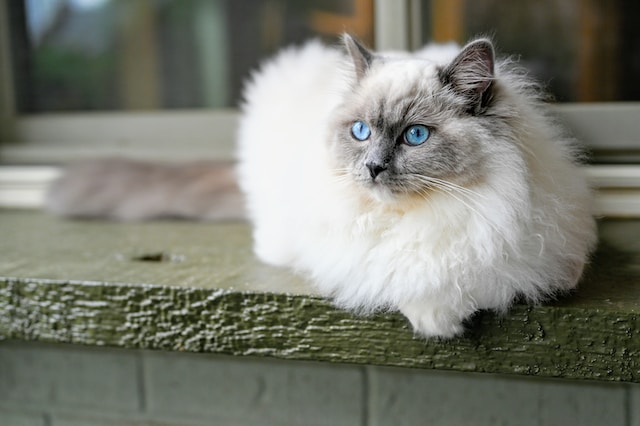Cats have long been cherished as beloved companions, and among the various cat breeds, the Ragdoll stands out for its stunning appearance, gentle nature, and unique personality. Originating in the 1960s, the Ragdoll cat breed has captivated cat lovers worldwide with its striking looks and docile temperament. In this article, we will examine the history of the Ragdoll cat breed, explore their suitability as pets, and provide special care instructions for those considering adding one to their family.

History
The Ragdoll cat breed was first developed by a breeder named Ann Baker in Riverside, California, in the early 1960s. The breed’s foundation cat, Josephine, a white longhaired female with striking blue eyes, was mated with various male cats of unknown origin. The offspring displayed a unique trait of going limp and relaxed when picked up, thus inspiring the name “Ragdoll.” Ann Baker selectively bred these cats to maintain their docile nature and specific color patterns, leading to the development of the Ragdoll breed.
Suitability as a Pet
Ragdolls are known for their friendly and gentle disposition, making them ideal companions for families, individuals, and even other pets. They are sociable and enjoy human company, often following their owners from room to room. Ragdolls are famous for their relaxed and trusting nature, often going limp in the arms of their caregivers, just like a ragdoll. This characteristic makes them excellent therapy cats, bringing comfort to those in need.
Moreover, Ragdolls are highly adaptable to various living situations. They can thrive in apartments as well as larger homes, provided they have enough space to play and explore. While they are generally indoor cats, Ragdolls can also be trained to walk on a leash, allowing them to enjoy supervised outdoor adventures.
Special Care Instructions
Ragdolls have a semi-longhaired coat that requires regular grooming to keep it looking its best. Weekly brushing is recommended to prevent matting and to remove loose hair. During shedding seasons, more frequent brushing may be necessary. Pay special attention to the areas behind the ears, the neck, and the hindquarters, as these are common places for tangles to form.
Additionally, regular dental care is essential for Ragdolls, as they can be prone to dental issues. Brushing their teeth several times a week with a feline toothbrush and toothpaste specially formulated for cats is recommended. Providing dental treats and toys designed to promote dental health can also contribute to maintaining their oral hygiene.
Due to their sociable nature, Ragdolls thrive on human interaction and can suffer from loneliness if left alone for extended periods. If you are away from home frequently, it is advisable to provide them with engaging toys and consider adopting a companion for them, be it another cat or even a friendly dog.
In terms of health, Ragdolls are generally robust cats. However, they can be prone to certain genetic conditions such as hypertrophic cardiomyopathy (HCM), a heart disease. Regular veterinary check-ups are crucial to monitor their overall health and detect any potential issues early on.
In conclusion, the Ragdoll cat breed is a delightful addition to any household. With their stunning appearance, calm demeanor, and affectionate nature, Ragdolls make wonderful companions. By providing them with regular grooming, dental care, and ample social interaction, you can ensure that your Ragdoll cat leads a happy and healthy life.
10 Fun Facts About Ragdoll Cats
Floppy and Laid-Back
Ragdolls are known for their unique tendency to go limp and relaxed when held or picked up, hence their name. This trait is called “floppiness” and is one of the defining characteristics of the breed.
Size and Weight
Ragdolls are large cats, known for their substantial size. They typically reach their full size and weight around four years of age. Male Ragdolls can weigh anywhere between 15 to 20 pounds, while females usually range from 10 to 15 pounds.
Slow Maturation
Ragdolls have a slower maturation process compared to other cat breeds. It can take them up to three or four years to fully develop both physically and emotionally.
Blue Eyes
One of the most captivating features of Ragdolls is their striking blue eyes. The intensity of the blue color varies, but it is a defining characteristic of the breed. However, some Ragdolls with specific color patterns, such as the mink and solid patterns, can have eye colors other than blue, such as aqua or green.
Color Patterns
Ragdolls come in a variety of color patterns, including seal, blue, chocolate, lilac, flame, cream, and tortie. These patterns can further be combined with different markings such as color points, mitted, or bicolor, resulting in a range of beautiful and unique appearances.
Gentle Nature
Ragdolls are renowned for their gentle and friendly disposition. They are known to be exceptionally tolerant and patient, making them great companions for families with children or other pets. They often seek out human interaction and enjoy being a part of the family’s activities.
Dog-Like Traits
Ragdolls have been described as having dog-like qualities. They can be trained to play fetch, walk on a leash, and even perform tricks. Some Ragdolls are known to greet their owners at the door when they come home, much like a loyal canine companion.
Minimal Shedding
Despite having a semi-longhaired coat, Ragdolls are surprisingly low shedders compared to other longhaired breeds. Their fur is less prone to matting, and regular grooming can keep shedding under control.
Water Fascination
Ragdolls are known to have a fondness for water. They may enjoy watching water flow, playing with water droplets, or even dipping their paws in a water bowl. Some Ragdolls might even join their owners in the shower or bath!
Slow Voice Development
Ragdolls have a slower development of their meowing and vocalization skills compared to other cats. They tend to have softer and quieter voices, adding to their overall gentle demeanor.
Related Articles & Free Email Newsletter Sign Up
Calico Cats Offer a Unique Coat Pattern and Can Bring Good Luck
Persian Cats Have Luxurious Fur and a Sweet Disposition

Comment here